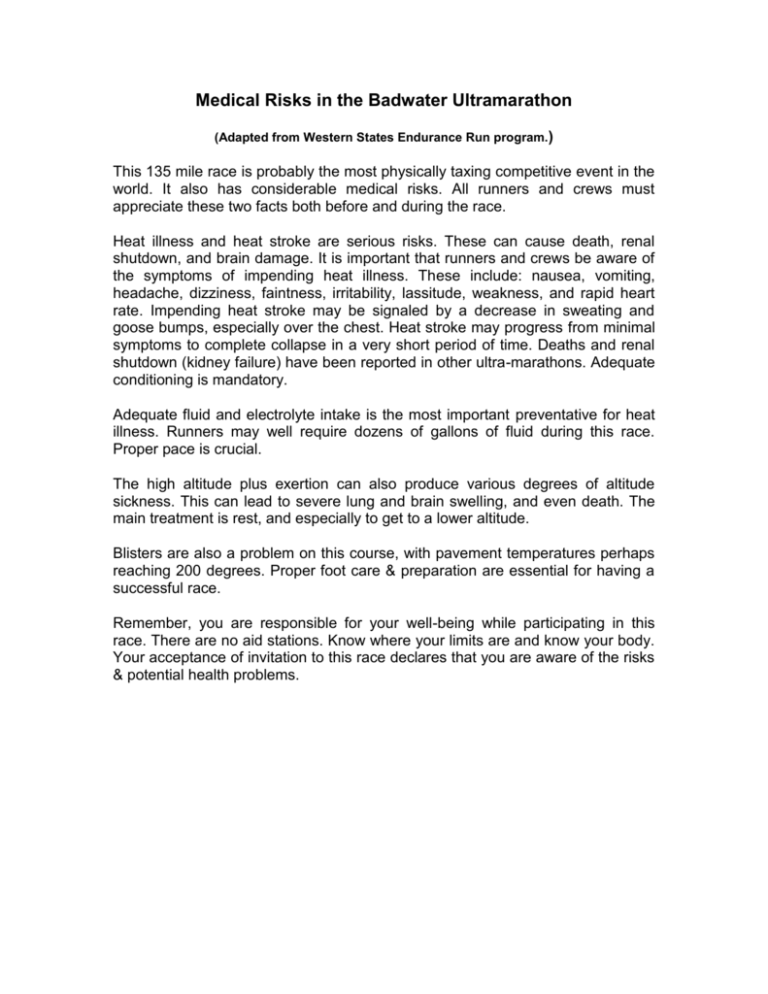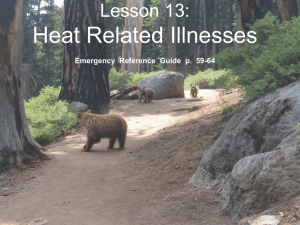Medical Risks in the Badwater Ultramarathon
advertisement

Medical Risks in the Badwater Ultramarathon (Adapted from Western States Endurance Run program.) This 135 mile race is probably the most physically taxing competitive event in the world. It also has considerable medical risks. All runners and crews must appreciate these two facts both before and during the race. Heat illness and heat stroke are serious risks. These can cause death, renal shutdown, and brain damage. It is important that runners and crews be aware of the symptoms of impending heat illness. These include: nausea, vomiting, headache, dizziness, faintness, irritability, lassitude, weakness, and rapid heart rate. Impending heat stroke may be signaled by a decrease in sweating and goose bumps, especially over the chest. Heat stroke may progress from minimal symptoms to complete collapse in a very short period of time. Deaths and renal shutdown (kidney failure) have been reported in other ultra-marathons. Adequate conditioning is mandatory. Adequate fluid and electrolyte intake is the most important preventative for heat illness. Runners may well require dozens of gallons of fluid during this race. Proper pace is crucial. The high altitude plus exertion can also produce various degrees of altitude sickness. This can lead to severe lung and brain swelling, and even death. The main treatment is rest, and especially to get to a lower altitude. Blisters are also a problem on this course, with pavement temperatures perhaps reaching 200 degrees. Proper foot care & preparation are essential for having a successful race. Remember, you are responsible for your well-being while participating in this race. There are no aid stations. Know where your limits are and know your body. Your acceptance of invitation to this race declares that you are aware of the risks & potential health problems. Dangers of Running in the Heat By Jason Hodde, MS, ATC/L (Originally published in Ultrarunning Magazine, September 2002. Reprinted with permission.) Running in hot weather can pose many dangers to ultrarunners. Although most runners are aware of the dangers of running for prolonged distances in hot and humid weather, many are also inadequately prepared for the intense stress placed on the body during these hot weather runs. This past July, I participated in the 25th anniversary of the Badwater Ultramarathon, a 135-mile trek from the lowest place in the continental United States (Badwater Basin), through Death Valley National Park, and to the foot of Mount Whitney, the Whitney Portals, at an altitude of 8,360 feet (2,548 meters). The run was held in the middle of one of the most severe heat waves southern California has ever seen. In preparation for the run, I made sure my crew was aware of the signs and symptoms of heat illness, as well as how to treat me should problems occur. Although the most extreme weather is likely behind us for the year, the combination of moderate heat and humidity can still make some of those fall ultras dangerous to your health. Here are some of the dangers of ultrarunning in the heat, and preventative measures that can be taken to avoid potential problems. The Heat Index The heat index is the apparent temperature felt by the body due to the combined effects of actual temperature and humidity. Most people understand that as the air temperature goes up, so does the heat index, but humidity also plays a role. As the humidity rises, the body is unable to efficiently evaporate the sweat it produces. Therefore, the perceived temperature is much higher than the actual air temperature. The loss of cooling efficiency thus makes exercise extremely dangerous. Although it is convenient to use a single number to describe the apparent temperature your body feels, keep in mind that heat and humidity affect everybody differently. Several assumptions are made to calculate the heat index measurements in the table below. Specifically, the heat index assumes the body to be: - 5' 7" (170 cm) in height 147 pounds (67 kg) in weight Caucasian A 98.6° F (37° C) body temperature - Clothed in long pants and a short-sleeved shirt In shade Walking at a speed of 3.1 mph (5 kph) In a breeze of 6 mph (10 kph) Not dripping with sweat Changing any of these factors can either increase or decrease the heat index from those shown in the table. Be aware that heat index values of over 100 significantly increase your risk of heat-related illness. Air Temperature (degrees Fahrenheit) Relative 70 75 80 85 90 95 Humidity Heat Index 0% 64 68 73 78 83 87 10% 65 70 75 80 85 90 20% 66 72 77 82 87 93 30% 67 73 78 84 90 96 40% 68 74 79 86 93 101 50% 69 75 81 88 96 107 60% 70 76 82 90 100 114 70% 70 77 85 93 106 124 80% 71 78 86 97 113 136 90% 71 79 88 102 122 150 100% 72 80 91 108 133 166 100 105 110 115 120 91 95 99 104 110 120 132 144 157 170 - 95 100 105 113 123 135 149 - 99 105 112 123 137 150 - 103 111 120 135 151 - 107 116 130 148 - Data from the US National Weather Service Heat Illnesses There are three major heat illnesses—and all of them can be exacerbated by ultra distance running and prematurely end an ultrarunner’s race. In all cases, the main reason that runners experience heat illness is dehydration. If you replace lost fluids and electrolytes and are able to train your body to process a high volume of fluid in a short period of time, you significantly decrease the risk of experiencing these race-ending medical emergencies. Heat cramps: Exercising in hot weather can lead to muscle cramps, especially in the legs. This is usually caused by imbalances or deficiencies in your body’s electrolyte stores. A cramp is characterized by sharp, stabbing pain in the muscle and rarely works itself out on its own. On a training run earlier this year in Death Valley, many runners complained of cramps in their legs; I suffered from cramps in my diaphragm and had difficulty breathing for more than an hour! Cramps become less frequent with heat training, but for those of us unaccustomed to such extreme conditions, maintaining adequate hydration and electrolyte balance is critical to avoiding them. To eradicate cramps, you should stop running, drink fluids containing electrolytes, cool your body with wet towels, and immediately get out of the sun. Heat exhaustion: Losing fluid and electrolytes through sweat leads to dizziness and weakness if the lost fluids are not replaced. Heat exhaustion is characterized by a moderate rise in body temperature, dizziness, nausea and vomiting, and a headache. You might also experience weakness, lack of coordination, heat cramps, heavier than usual sweating accompanied by moist and cold skin, and “goose bumps.” Your heart rate may rise and you won’t be able to run as fast due to fatigue. Many runners – even those who are well trained – will suffer from mild heat exhaustion after running for several hours in hot and humid conditions. If you experience the signs of heat exhaustion, stop running immediately and drink fluids containing electrolytes, cool your body with wet towels, lie down and elevate your feet a few inches above your heart, and immediately get out of the sun. Since heat exhaustion can lead to the most severe form of heat-related illness, heat stroke, seeking prompt medical attention for heat exhaustion is also highly recommended. Heatstroke: In extreme cases heat can upset the body's thermostat, causing body temperature to rise to105 degrees F or higher. This is a life-threatening situation that requires immediate medical attention. While it is common for untreated heat exhaustion to rapidly progress to heatstroke, heatstroke can (and does) occur without the signs of heat exhaustion being apparent. Symptoms of heatstroke include lethargy and extreme weakness, confusion and odd or bizarre behavior, disorientation and unconsciousness. Because heatstroke is a complete failure of the body’s temperature regulation system, sweating ceases and the skin becomes hot and dry. Convulsions or seizures can occur as the brain begins to shut down. Coma and death are also possible in extreme cases. Heatstroke is a medical emergency that requires immediate medical attention. Call the emergency response system immediately! Get the runner out of the sun, remove all clothing, and immediately rub their body with ice or immerse the runner in cold water. By staying properly hydrated and recognizing the early warning signs of heat illness, as a runner you can prevent a heat-related problem from becoming a lifethreatening situation. As a volunteer, recognizing these heat-related dangers may one day help you save the life of a runner who has underestimated the intensity of the surroundings. Jay is a nationally Certified Athletic Trainer (ATC) licensed to practice in Indiana. He holds Master’s degrees in Exercise Physiology and the Basic Medical Sciences, both from Purdue, with an emphasis on tissue repair and healing. He is currently pursuing a Ph.D. in Pathology, where his emphasis is on the immunopathologic response to soft tissue implants. Jay also works fulltime as a scientist for Cook Biotech Incorporated, a medical device company in Indiana. He has completed over 60 ultramarathons, including the Grand Slam of Ultrarunning, but has yet to conquer the Death Valley heat. The Dangers of Hot Weather Running: Dehydration, Heat Cramps, Heat Exhaustion, Heatstroke & Hyponatremia By Claudio Piepenburg (Originally published by Road Runner Sports) Running in hot weather can pose dangers to runners. Particularly dangerous is racing in hot, humid summer conditions. Here’s how to protect yourself from these five serious (and potentially fatal) conditions. Dehydration Dehydration is not limited only to the summer months, although it’s probably more likely to occur during that time. Many physicians believe that most people are in a constant state of dehydration. Since coffee, tea, soda and alcohol act as a diuretic, anyone who drinks these fluids on a daily basis, and doesn’t drink at least an equal amount of water, will probably be dehydrated. If the person is physically active, the potential for dehydration is even greater. Working out in hot, humid conditions promotes sweating, which in turn can cause dehydration. Sweating is good for you because it cools your body, but when you lose too much water you become dehydrated. If you’re already slightly dehydrated, sweating will only make it worse. It’s important to maintain an adequate fluid intake all the time. Don’t expect that you can make up for several days of not drinking enough by downing two cups of sports drink before your next long run or race. It’s important to keep hydrated all the time. Once you start to feel thirsty, it’s too late. The average (sedentary) person needs a minimum of eight 8-ounce glasses of fluid a day. Runners need more: anywhere from four to eight quarts of fluid. That translates to at least sixteen 8-ounce glasses daily. Remember that diuretics don’t count! Drink water and sports drinks, and if you don’t have to worry about calories, fruit drinks or juice. Two hours before your daily summer workout or a race, you should drink 16 ounces of fluid. Then ten minutes or so before you start to run, drink another one or two cups of water or sports drink. Drinking early and drinking often is the key. During a race you should drink six to twelve ounces of fluid every 15-20 minutes. If the weather is very hot, you may need to drink even more. Training in warm weather, you should drink at least every 35 to 40 minutes. (Remember you will have already had two 8-ounce glasses before you started.) If you’re running a race shorter than 30 minutes, you probably won’t need any water other than what you drank before the start. The same goes for the last few miles of a longer race. If you’re racing or training for longer than an hour, drink sports drinks as opposed to strictly water. Start drinking immediately after finishing a run, no matter if it was a race or a workout. Minimum is 16 ounces for every 30 minutes you ran. If you tend to sweat a lot, you’ll need more. Weigh yourself after you’ve run. Drink at least 16 ounces of fluid for every pound you lose through sweating. By monitoring the color of your urine you can tell if you’re hydrated. It should be pale yellow or even clear. If it isn’t, you need to drink more fluids. It’s important that you retain the fluid, so be careful it you’re urinating every fifteen or twenty minutes. To restore your fluid balance, eat something salty (a bag of pretzels, salted nuts, crackers or potato chips), then drink a sports drink. The salt will make you thirstier, so you’ll take in even more fluid and urine production will decrease. Heat Cramps Have you ever seen a runner bent over at the side of the road massaging their calves during a race? Chances are that he or she had heat cramps. Heat cramps are very painful (envision someone stabbing a knife deep into your muscles!) and rarely “work themselves out”. The cramps occur because you’ve lost minerals through sweating and dehydration. Once you’ve reached the point of heat cramps, it’s too late to try to replace fluids on the run. To make the cramps go away you should: - Stop running Drink fluids immediately. The fluids should include sports drinks as well as water Massage the muscles once the pain begins to subside Cool your body with wet towels Get out of the sun Heat Exhaustion Heat exhaustion is a very serious condition that can lead to heatstroke. The symptoms of heat exhaustion are: - Dizziness “Goose bumps” (particularly on the torso and arms) Nausea (sometimes accompanied by vomiting) Moderate to severe headache Weak legs Lack of coordination - Rapid pulse Heavy sweating often accompanied by moist and cold skin Muscle cramping If you experience any of these symptoms you must: - Stop running immediately Get medical attention Drink large amounts of fluids, including sports drinks Get out of the sun Lie down and elevate your feet above your heart Loosen your clothing Heatstroke Heatstroke can be fatal. Unfortunately runners will sometimes ignore the symptoms of heat exhaustion (particularly in races longer than 10K) and will continue to push themselves until they’re nearing a total thermoregulatory breakdown. The symptoms of heatstroke are very similar to those of heat exhaustion, but rapidly progress to: - Disorientation Weakness in the legs to the point that the runner may fall Strange behavior (including flailing with the arms and shoving) “Fuzzy” thinking Rapid pulse Cessation of sweating and hot/dry skin Body temperature that may reach 104 degrees or higher Lack of consciousness Convulsions or seizures Coma Someone suffering from heatstroke needs immediate medical attention. They should be moved out of the sun, cooled by either rubbing their body with ice or immersing them in cold water and given fluids intravenously. Hyponatremia Within the last few years the condition known as hyponatremia has begun to attract the attention of sports medicine physicians, exercise physiologists, and the medical directors at some of the larger marathons around the country. Hyponatremia has been called water intoxication because of the symptoms it produces. According to Dr. Tim Noakes, Professor of Exercise & Sports Science Director at the University of Cape Town, “…a person with hyponatremia looks like he or she is mildly drunk. They can’t concentrate normally…they forget what you were talking about and start to concentrate elsewhere.” Hyponatremia occurs when the body becomes dangerously low in sodium. It’s caused when you literally take in too much water. Although scientists have known about it for a long time, it has only been in the last few years as more runners have been competing in marathons that it has become a concern. According to Dr. Noakes, fluid has to be ingested at high levels for several hours for hyponatremia to occur. He suggests that a runner would have to be drinking water regularly for at least four to six hours to develop the condition. So runners taking four to six hours or more to run a marathon are at particular risk. Unfortunately, symptoms of hyponatremia tend to mimic those of severe dehydration and/or heat exhaustion. By giving the athlete more water to drink the hyponatremia becomes worse, as more and more sodium is flushed out of the system. If a runner with hyponatremia is given fluids intravenously, they can suffer a fatal reaction. Dr. Noakes and other sports medicine professionals recommend that physicians and other medical personnel at road races be alert for the signs of hyponatremia. One of the earliest symptoms is a craving for salty food. Although hyponatremia is rare, it’s wise to be aware that it can occur, particularly if you’re running a marathon in unusually hot weather. Hyponatremia serves as a reminder that water is good, but don’t forget sports drinks, which replenish your body with the sodium, potassium and other trace minerals you lose through sweat. It’s worth repeating: if you’re going to be running (or racing) for longer than an hour, you should be drinking a sports drink as well as water. About the author: Claudia Piepenburg has been running for 21 years and is the current editor for Peak Run Performance. She holds or has held state age-group records in Michigan, North Carolina, Florida, Tennessee and Virginia. In 1990, she was ranked 18th fastest masters woman in the world and 8th fastest masters woman in the U.S. in 1990 and 1991. She competed in the 1988 Olympic Marathon Trials, was 20th woman overall in the 1987 Boston Marathon and women's winner of the 1986 Virginia Beach Marathon. If you have questions or comments for Claudia, she can be reached at cpiepe@roadrunnersports.com. Super Dave’s hot weather racing tips 1. Ditch the cotton T-shirt. You’ve heard this countless times before but it still blows me away to see you running in cotton t-shirts. If you have to, wear them during training. When race day comes around, you want every performance edge you can get. Cotton is hot and gets heavy with sweat, both of which will slow you down. CoolMax“ on the other hand is lightweight all the time and breathes. 2. Wear Sunscreen. The sun sucks energy out of you especially if it is given the chance to burn you. The best sunscreen I have ever used (It holds up for 10+ hours in the heat of Kona at the Ironman) is Banana Boat Sport. 3. Wear a coolmax hat – read #1 and #2 for reference. 4. Go with a lighter weight sock. Your feet will swell more in the heat. A lighter weight sock will breathe better and allow for the swelling. 5. Train in the heat. The best way to get used to racing in heat is training in heat. Make sure if you do this to pay attention to items 1 through 4 and stay hydrated. 6. Drink at every aid station on the course. This way you maintain your hydration levels. At the end of the race if you feel hydrated enough, you can skip the last aid station. At the end of the race, if you are dehydrated, nothing can help you until you cross the finish line and stop your activity. 7. Stay out of cold air-conditioned rooms. If at all possible, the day before and the morning of the race, stay out of cold rooms. The shock to the body from that really cold room to the really hot race will be less. 8. Make sure you continue hydrating immediately after the event. Your body continues to sweat to stay cool long after you have finished. If you stop hydrating or worse yet, head to the beer tent, you will slow down your recovery dramatically. 9. Wear the same coverage of clothing you do during training. There is nothing worse than wearing a different cut of shorts than you normally wear. The night after the race you notice that your skin that is not normally exposed to sun is not hot pink and stings. You look funny when you sit down in the nylon lawn chair that evening. 10. If you are near a body of water at the finish, go stand waste deep in the water. The cooler water will help your legs recover. My favorite thing to do here in San Diego after a long hard run is to dip my legs into the cool 68-degree Pacific.





